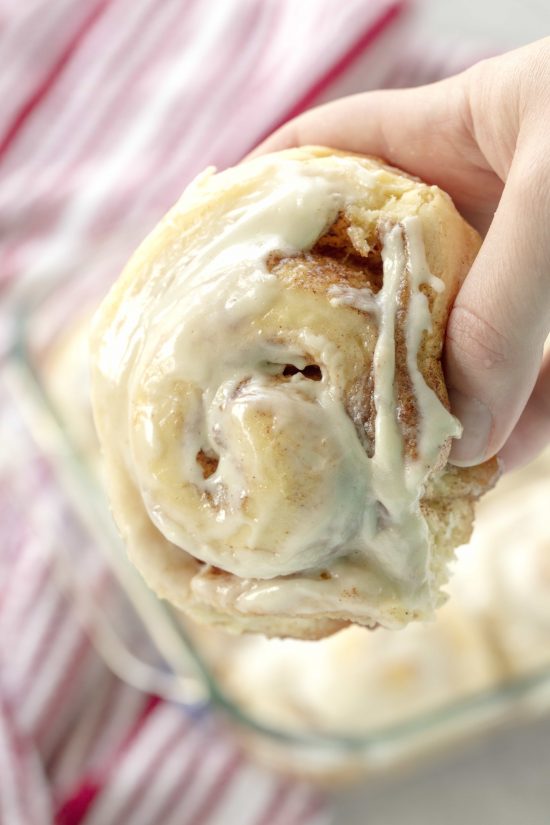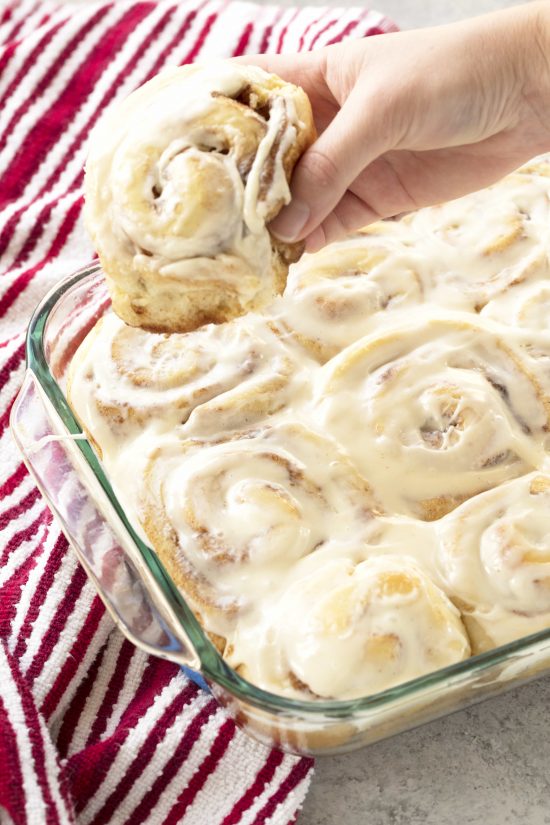THE BEST HOMEMADE CINNAMON ROLLS EVER!
This recipe is hands down the Best Homemade Cinnamon Rolls Recipe Ever. The perfect soft, fluffy, gooey cinnamon rolls are right at your fingertips. This is the only recipe you’ll ever need.
These are the perfect cinnamon rolls. They are soft, fluffy, and gooey all at the same time. They melt in your mouth when they are still warm. Basically, they are to die for. I have to be careful when I make them because we literally eat the whole pan at once. And there are only four of us.

MAKE AHEAD INSTRUCTIONS
These cinnamon rolls can easily be made ahead. For best results, choose one of the following two methods.
OVERNIGHT INSTRUCTIONS: After you’ve rolled and cut your cinnamon rolls and placed them into your lightly greased baking pan, cover with plastic wrap and place in your refrigerator. The next day, remove them from the fridge and allow them to come to room temperature (about 45 minutes to an hour depending on the temperature of your house) before baking.
FREEZER INSTRUCTIONS: Roll and cut your cinnamon rolls and place several inches apart on a baking sheet to freeze rolls individually. Once frozen, transfer to a resealable plastic freezer bag. When ready to bake, place in a lightly greased baking dish and allow to come to room temperature before baking.

Can these be made gluten free?
I have not personally tested any variations of gluten free flours. It has been reported to me that the gluten free flour mix “Cup for Cup” works in this recipe, but I cannot personally vouch for it.
What if I don’t have a stand mixer?
You can knead it by hand! My Kitchen Aid was broken for more than a year and I still made these rolls by hand. I start out by stirring with a spoon until I can’t do it anymore and then I knead it with my hands. Just keep on kneading until all the flour is incorporated and/or the dough is soft to the touch and only slightly sticky. It’s a bit of a workout, but it’s worth it!
Can I reduce the salt in this for a low sodium diet?
Reducing the salt will not affect the rising. The only thing it will impact is flavor.
What temperature should the milk be?
The milk should be warm to the touch, between 100 and 110 degrees. You can use 1% up to whole milk. I’ll never recommend using skim milk for anything 

How should I measure the flour?
The flour you buy at the store these days is generally pre-sifted. There is no need to sift your flour. I prefer the scoop and sweep method as it is ultra-convenient. Simply use your measuring cup to scoop out the flour and level off the top. Weighing your flour using a kitchen scale is the only way to ensure complete accuracy. Even then, bread making is a both fickle and forgiving and the actual amount of flour you add can change just due to the humidity in the air. When making this roll recipe, it is best to go by the touch and feel of the dough.
1 cup of flour is approximately 125 grams.
How soft should my butter be?
The butter should be at room temperature and smoosh easily to the touch. If you soften the butter in a microwave, be sure to work in small time increments so you don’t get any melted pools of butter.
Does it matter if I use unsalted butter?
I have tested the recipe with both salted and unsalted butter without a huge or notable difference. Either will work.
Does it matter if I use bread flour?
I have used both all-purpose flour and bread flour without a huge or notable difference. I do not have a preference and just use whichever is convenient.
What should the dough feel like?
The dough should be slightly sticky, but still very soft and pliable. It should just barely not be sticking to the bowl. If you add too much flour and the dough stiffens, your rolls will also get a little stiff. I like to say you can feel a soft roll just by touching the dough.
all image & recipes adapted by thestayathomechef.com
Ingredients
Dough
- 1 cup warm milk
- 1 tablespoon instant dry yeast
- 2 tablespoons white granulated sugar
- 1 teaspoon salt
- 3 tablespoons salted butter, softened
- 1 large egg
- 3 cups all-purpose flour
Filling
- ½ cup salted butter, melted
- 1 cup brown sugar
- 2 tablespoons ground cinnamon
Glaze
- 4 ounces cream cheese, softened
- ¼ cup salted butter, softened
- 1 to 1½ cups powdered sugar
- ½ teaspoon vanilla extract
- 1 to 2 tablespoons milk
Instructions
- In the bowl of a stand mixer, combine warm milk, yeast, sugar, salt, butter, and eggs. Add in flour. Using a dough hook, turn the mixer on to a low speed.
- Once the flour starts to incorporate into the dough, increase the speed to a medium range. Add more flour as necessary so that the dough pulls away from the sides of the bowl. The dough mixture should be tacky, but not stick to your hands. It should be soft. Add more or less flour until the dough reaches the desired consistency. The amount of flour you add in bread making is always an approximation and you should go by feel.
- Transfer the dough to a lightly greased mixing bowl. Cover with a towel and let rise until double in size, about 1 hour.
- Lightly grease a baking sheet. Punch down the dough and roll into a 12inch by
18inch rectangle. - Brush the dough with ½ cup melted butter. In a small bowl, combine the brown sugar and cinnamon. Sprinkle on top of the melted butter. Roll up tightly lengthwise so you have one long roll. Use plain dental floss or a sharp knife to cut the dough into 12 one-inch slices.
- Place the slices onto a lightly 9x13 pan. Cover and let rise 30 to 45 minutes.
- Preheat oven to 325 degrees. Bake the rolls for about 14 minutes, until just kissed with brown on top.
- While the cinnamon rolls are baking, make the cream cheese glaze by using a hand mixer to whip together cream cheese and butter in a bowl until light and fluffy. Whip in powdered sugar and vanilla extract. Add enough milk to achieve a drizzle-like consistency.
- Frost the rolls while still warm. Serve immediately or cool and store. Stays good for 4 to 5 days.
Notes
***Some have reported undercooked rolls. Cooking time is dependent on the size of your rolls. You should cook the rolls until they have just a kiss of brown on the top. If they don't have a kiss of brown, they probably aren't done. Cooking time may be upwards of 18-20 minutes.
***METRIC MEASUREMENTS
Dough
236.5 mls warm milk
10 grams instant dry yeast
26 grams white granulated sugar
8 grams salt
40 grams salted butter, softened
1 large egg
375 grams all-purpose flour (approximate)
7.5 grams melted butter
Filling
114 grams melted butter
200 grams brown sugar
15 grams ground cinnamon
Glaze
115 grams cream cheese
113.4 grams butter
125 grams confectioner's sugar
2.1 grams vanilla extract
15 to 30 grams milk
***METRIC MEASUREMENTS
Dough
236.5 mls warm milk
10 grams instant dry yeast
26 grams white granulated sugar
8 grams salt
40 grams salted butter, softened
1 large egg
375 grams all-purpose flour (approximate)
7.5 grams melted butter
Filling
114 grams melted butter
200 grams brown sugar
15 grams ground cinnamon
Glaze
115 grams cream cheese
113.4 grams butter
125 grams confectioner's sugar
2.1 grams vanilla extract
15 to 30 grams milk
all image & recipes adapted by thestayathomechef.com

BERITA LENGKAP DI HALAMAN BERIKUTNYA
Halaman Berikutnya
0 Response to "THE BEST HOMEMADE CINNAMON ROLLS EVER!"
Posting Komentar